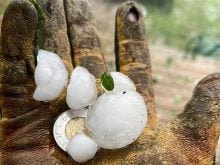A University of Saskatchewan archeology student is looking into a past spring ritual.
Lyndsay Stokalko wants help from prairie residents as she researches her thesis on lime kilns. Settlers used the kilns to create quicklime for use in mortar and plaster to whitewash their houses’ exteriors and interiors every spring.
She wants to find old kiln sites, hear people’s stories about kiln use and explore how different ethnic groups used the lime in their buildings.
She saw a lime kiln while working at the Borden, Sask., museum last summer.
Read Also

Agri-business and farms front and centre for Alberta’s Open Farm Days
Open Farm Days continues to enjoy success in its 14th year running, as Alberta farms and agri-businesses were showcased to increase awareness on how food gets to the dinner plate.
Limestone outcroppings are easier to find along eroded shorelines so many kilns were located near the river.
The process to create quicklime in kilns would take about a week with a day for loading the limestone, two or three days of burning at high temperatures and a day to cool and then remove the quicklime.
She knows of three kilns east of Saskatoon but would like to explore more sites from North Battleford to Prince Albert, Sask.
For more information, contact Stokalko at 241-2919 or las136@mail. usask.ca.














